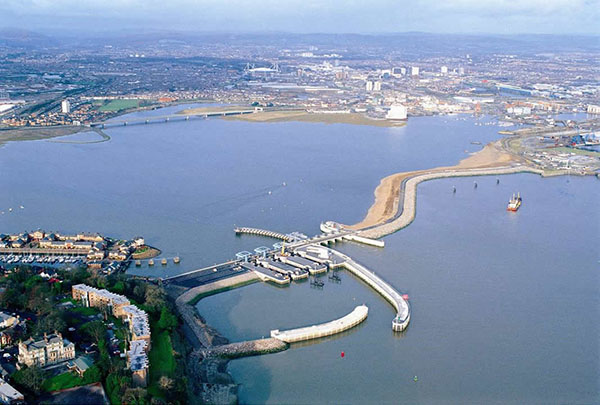The Cardiff Bay Barrage lies across the mouth of Cardiff Bay, Wales between Queen Alexandra Dock and Penarth Head. It was one of the largest civil engineering projects in Europe during construction in the 1990s.The concept of a barrage was first suggested in the 1980s as a way to help regenerate Cardiff”s largely disused docklands. The barrage would create a large freshwater lake intended to attract investment into the docklands.
The bay was part of the Bristol Channel which has the second largest tidal range in the world. As a result, for half of the day, the bay was empty of water, leaving large unappealing mudflats exposed. The barrage was consequently seen as central to the regeneration project. The government established the Cardiff Bay Development Corporation to build the barrage, and to redevelop the area as a whole.
Opposition
Opposition to the project came from many quarters. Some local politicians (including the area’s MP, Rhodri Morgan, now First Minister of the Welsh Assembly) said the scheme would cost too much money. Local residents feared that their homes would be damaged by the permanently raised water level. Environmental groups strongly opposed construction because the bay was an important feeding ground for birds, which would be lost following impoundment.
Construction
Construction, which was undertaken by a Balfour Beatty / Costain Joint Venture, started in 1994, following the successful passage of the Cardiff Bay Barrage Act of 1993 through the UK Parliament. The bill included provisions for compensation for any homes damaged by the barrage and a large wetland habitat for birds further east down the Bristol Channel. Features include a fish pass to allow salmon to reach breeding grounds in the River Taff and three locks for maritime traffic. Construction was completed in 1999 and shortly afterwards the barrage came into effect. The impounding of the River Taff and River Ely created a 2 km² (500 acre) freshwater lake.
Today
The barrage has played an important role in the regeneration of the area. Attractions such as the Wales Millennium Centre, the National Assembly for Wales, shopping and watersports have since moved onto the waterfront. In 2000 the Cardiff Bay Development Corporation was dissolved, and the Welsh Assembly awarded a contract to Cardiff County Council to manage the barrage, as the Cardiff Harbour Authority (CHA).
One of the major selling points of the proposed development was the opening up of a new pedestrian and cycle route across the barrage. This would not only enhance tourism on both sides but provide a pleasant and safe short-cut between Cardiff and Penarth, cutting two miles off the journey otherwise taken on the heavy-traffic roads further upstream. However, this benefit took years to materialise due to a lack of agreement between the derelict access land owners (Associated British Ports) and Cardiff Council. The “unfinished” barrage was the cause of much embarrassment to the Welsh Assembly. The Cardiff Harbour Authority have made significant progess in the creation of bay edge walkway and have redeveloped a large portion of the previously unaccesible bay periphery. The barrage was finally completed and open to the public on Monday 30 June 2008, allowing public access from Mermaid Quay to Penarth Marina. The Cardiff Harbour Authority has developed a Sea Angling zone on the outer breakwater arm.
The barrage has been short listed for the British Construction Industry Award (BCIA) to find the ‘Best of the Best” construction project over the last 20 years.
Impact on the ecology of Cardiff Bay
According to two studies published in 2006, the loss of intertidal mudflats has resulted in the numbers and diversity of the birds using Cardiff Bay greatly reducing. Almost all of the Common Shelduck and shorebirds that used the bay when mud was exposed no longer feed there. Initially these birds used nearby sites to feed, but in most cases, this behaviour was not sustained, and the birds were unable to settle elsewhere. Common Redshanks displaced from Cardiff Bay settled at the nearby Rhymney estuary, but they exhibited lower body weight, and their annual survival rate declined from 85% to 78% as a result of lower levels of winter survival. As a result of this loss of birdlife they opened Newport Wetlands Reserve in 2000 some 12 miles down the road.
Discover more from LandmarkLocation.com
Subscribe to get the latest posts sent to your email.


